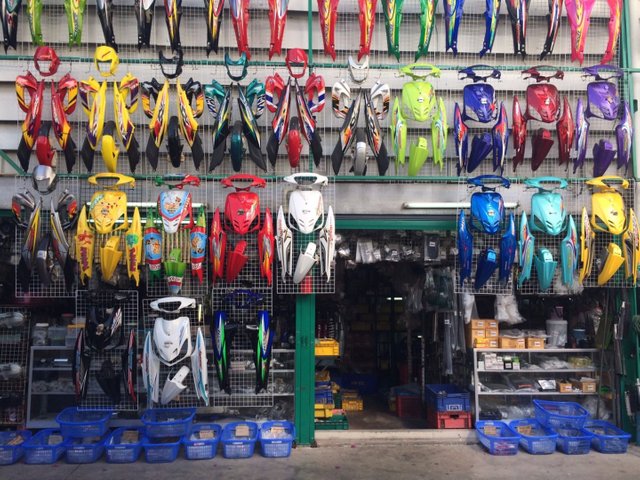Recognizing the Vital Parts of a Bike: A Comprehensive Overview for Fanatics
For motorbike enthusiasts wanting to raise their riding experience and ensure their bikes run efficiently, recognizing the crucial elements of a motorbike is paramount. Each element, from the engine's elaborate operations to the critical function of the braking devices, not only influences efficiency however likewise security and comfort. This overview will stroll with the essential parts that every rider must recognize with, allowing informed selections in both upkeep and potential upgrades. As we begin this exploration, one must ask: how does each part engage to produce the smooth experience every fanatic looks for?
Engine Components

The camshaft plays an important role in managing the timing of the engine's shutoffs, making certain the specific opening and closing essential for efficient fuel and air consumption, as well as exhaust expulsion. This timing is critical to maintaining ideal engine efficiency and effectiveness. Additionally, the carburetor or fuel injection system, depending on the motorcycle design, is accountable for mixing air with fuel in the appropriate proportion for burning.
The cooling system, either air or liquid-based, functions to preserve the engine's temperature level within functional restrictions, preventing getting too hot and making certain durability - motocross gear nz. Each element, carefully made and integrated, contributes to the smooth operation of the engine, specifying the bike's power outcome and general performance
Transmission System
Integral to the bike's performance, the transmission system makes sure effective power transfer from the engine to the wheels. This system comprises a number of crucial elements, consisting of the clutch, gearbox, and final drive, each playing an essential duty in translating the engine's power into movement. The clutch, typically run by a hand lever, serves to disengage the engine and engage from the transmission, permitting smooth gear changes and regulated acceleration.
The gearbox, commonly described as the transmission proper, has a collection of equipments that motorcyclists can by hand move with to readjust the bike's rate and torque outcome. These equipments are arranged in a sequence that allows the motorbike to accelerate efficiently and preserve optimal engine efficiency across different speeds. A lot of bikes make use of a consecutive transmission, requiring the motorcyclist to move gears in an established order.
Braking Mechanisms
While understanding the transmission system is key to using a motorcycle's power, equally vital is the capacity to regulate and stop that power successfully, which is where stopping devices come right into play. Brakes are important for safety and security and performance, supplying the cyclist with the needed control to navigate various terrains and conditions. Normally, motorbikes include 2 kinds of braking systems: disc brakes and drum brakes.
Disc brakes are extra prevalent in modern-day motorcycles because of their exceptional performance. They consist of a brake disc, caliper, and pads. When turned on, the caliper presses the brake pads versus the spinning disc, transforming kinetic power into heat, thus slowing down the wheel. This system offers better warm dissipation, regular efficiency, and improved quiting power, specifically in damp problems.
Conversely, drum brakes, though much less usual, are still found in some motorbikes. They function by pressing brake shoes versus the internal surface of a drum connected to the wheel. While normally less reliable in heat dissipation and stopping power, drum brakes are less complex and much more cost-effective.
Comprehending these braking systems' subtleties enables motorcyclists to preserve their bikes appropriately and appreciate the engineering that makes certain efficient and risk-free quiting.
Suspension and Steering
Suspension and steering systems are crucial parts that considerably influence a bike's handling and ride comfort. The shock absorber, including forks at the front and shock absorbers at the rear, absorbs roadway abnormalities, improving security and control. Front forks, upside down or generally telescopic, compress and rebound to mitigate influences, while back shock absorbers keep tire call with the road, crucial for traction and safety and security.
Guiding, centered around the handlebars, connects the cyclist to the motorbike's directional control. The guiding head bearings ensure smooth procedure, allowing precise ability to move. Correct placement and maintenance of these bearings are crucial for foreseeable guiding action and lowering biker exhaustion.
The suspension's adjustability is an additional critical aspect; preload, damping, and rebound settings allow modification to match various he said riding problems and styles. This flexibility is necessary for optimizing efficiency, whether browsing city roads or taking on sturdy tracks. Developments like digital shock absorber use real-time changes, improving trip high quality throughout diverse surfaces.

Electrical Equipments
After guaranteeing a regulated and smooth adventure with reliable suspension and guiding systems, focus turns to the electric systems, a pivotal aspect of modern bikes. These systems play a critical function not just in beginning the engine however additionally in powering numerous components that improve the functionality and safety and security of the motorbike.
At the heart of a bike's electric system is the battery, which shops electric power required for beginning the engine and powering complementary systems - moto parts nz. The alternator or generator, combined with the rectifier-regulator, ensures the battery remains billed while the motorcycle functions, converting power into electrical power and preserving voltage levels
The ignition system, another crucial element, is accountable for firing up the air-fuel mixture in the engine's cylinders. Modern motorbikes commonly make use of an electronic ignition system, providing greater efficiency and integrity contrasted to traditional systems.
Lights systems, including headlights, tail lights, and indicators, are also essential, ensuring visibility and safety and security for the cyclist. Extra digital components such as sensing units, control devices, and presents you can try these out contribute to advanced attributes like gas injection administration, anti-lock braking systems (ABDOMINAL), and electronic dashboards, further enhancing the riding experience.
Verdict
A detailed understanding of a motorcycle's important components, consisting of the engine, transmission system, braking systems, suspension, steering, and electric systems, is vital for lovers intending to optimize convenience, security, and performance. Mastery of these elements permits notified decisions regarding maintenance and upgrades, inevitably improving the riding experience. By integrating this understanding, cyclists can ensure their motorbikes operate at peak effectiveness and integrity, thus taking full advantage of both satisfaction and long life of their vehicles.
For motorcycle lovers looking to boost their riding experience and ensure their bikes run efficiently, understanding the necessary parts of a motorcycle is vital.Integral to the motorcycle's performance, the transmission system makes certain reliable power transfer Click This Link from the engine to the wheels.While comprehending the transmission system is vital to utilizing a motorbike's power, similarly vital is the capability to manage and quit that power successfully, which is where stopping mechanisms come right into play. Typically, motorcycles feature two kinds of braking systems: disc brakes and drum brakes.
A complete understanding of a motorbike's necessary components, consisting of the engine, transmission system, braking systems, suspension, steering, and electric systems, is indispensable for enthusiasts aiming to maximize safety and security, convenience, and performance.